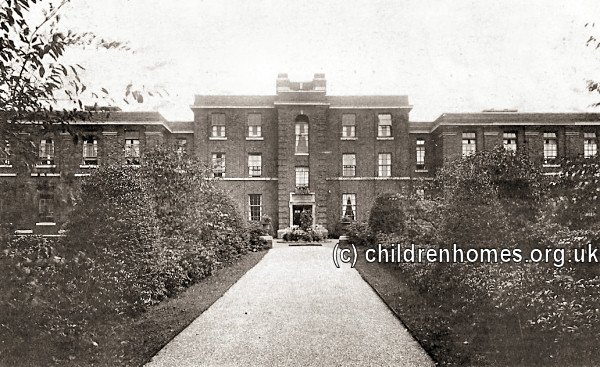Ladies' Jubilee Charity School, Manchester, Lancashire
In February, 1808, the proposal was made to establish a Girls' Charity School, where 'a certain number of female children will be maintained, clothed, and educated, taught reading, writing, sewing, marking, knitting; and when they have attained a proper age they will be instructed in every necessary qualification to make them useful household servants; so that at the period of fifteen or sixteen they will be enabled to earn a creditable livelihood, either by their independent labour, or, by their services in respectable families.'
At a public meeting in October, 1808, to consider celebrations for the approaching Golden Jubilee of King George III, it was resolved to mark the event by erecting a building for the charity. Fund raising began and the sum of £1,117 was raised. This, together with a £500 legacy from Thomas Henshaw of Oldham, enabled the construction of the School at a site on New Bridge Street, on the borders of Strangeways Park. The land was obtained on a 99-year lease, from October 1810, from Lord Ducie at an annual rent of £15,
In 1867, the Ladies' Committee complained about the heavy annual cost of painting and maintaining the building which was now said to be old and dilapidated. The following year it was reported that the building was worn out, and the possibility was discussed of selling the property and moving to a more open site, the Strangeways district having become heavily built up since the School was founded. However, being locked into a further 40 years of the site's lease, the committee abandoned the idea. In 1901, with the lease coming towards its end, Lord Ducie was asked if the lease could be renewed. As anticipated, the answer was in the negative, and a new site was sought away from the centre of the town. A suitable plot of land was found on Bury Old Road, in the Broughton district of Manchester, where a new building was erected at a cost of £8,000
The new School was formally opened by the Bishop of Manchester on November 12th, 1912. The premises could accommodate up to 60 girls, aged 7 to 11 years at their date of admission. The establishment was now usually known simply as the Jubilee School.

Manchester Jubilee School, Manchester, c.1920. © Peter Higginbotham
At the start of the Second World War in 1939, the School moved to 'Lerryn', a house on Carrwood (or Carr Wood) Road, Bramhall, near Stockport. The property had previously been the home of Sir Robert McDougall, a former chairman of the charity.
By 1958, a decline in the number of girls entering the School led to the charity merging with the Manchester and Salford Boys' and Girls' Refuges, the new organisation being renamed the Boys' and Girls' Welfare Society (BGWS) in 1960. Although 'Lerryn' was taken over by the BGWS, it was considered to be too small and was sold off.
The BGWS was renamed the Together Trust in 2005 and the charity now offers care, support and special education to children, adults and families, including those with particular physical, behavioural or learning difficulties.
The Bury Old Road building now houses a Jewish cultural centre and special needs school. The New Bridge Street premises and the Bramhall 'Lerryn' no longer exist.
Records
Note: many repositories impose a closure period of up to 100 years for records identifying individuals. Before travelling a long distance, always check that the records you want to consult will be available.
- Greater Manchester County Record Office (with Manchester Archives), Archives+, Manchester Central Library, St Peter's Square, Manchester M2 5PD. Holdings include: Minutes of various committees (1830-1953); Applications for admission (1856-1920, 1930-1956;) Register of girls (1810-1955); Visitors' book (1912-1953); Various ledgers and account books (1910-1960); Regulations and instructions (1857); Annual reports (1867-1956, with small gaps).
Census
Bibliography
- Higginbotham, Peter Children's Homes: A History of Institutional Care for Britain s Young (2017, Pen & Sword)
Links
Except where indicated, this page () © Peter Higginbotham. Contents may not be reproduced without permission.


